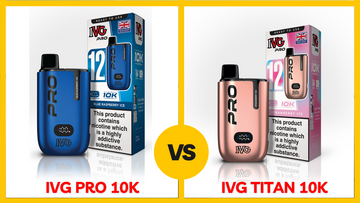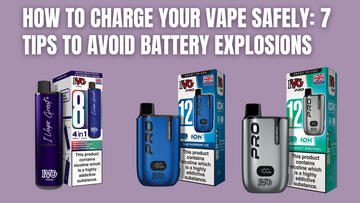Ensuring the safety and longevity of your e-cigarette batteries is crucial for both your safety and the performance of your device. Improper handling or storage of batteries can lead to accidents or reduced battery life. Below, we’ve compiled essential tips to help you care for your e-cigarette batteries responsibly.
Safety Information For E-Cigarette Batteries
Here at Vape Shop, the safety of our customers is a primary concern for us and we want to ensure that you have an accident-free vaping experience. As the world of vaping continues to develop and expand, it’s becoming more and more imperative that vapers are aware of the safety issues surrounding e-cigarettes. Although vaping is not a dangerous activity, there are some rules of safety that must be adhered to. The main safety hazard within an e-cig comes from the battery, so we have compiled this guide to ensure that you stay safe whilst using any of our products containing batteries. Please take a look at our battery safety guide here.
About Lithium Ion Batteries
Lithium Ion batteries are safely used in millions of devices around the world, every day. As with most high energy devices, there are various risks that users should be aware of when using them. Batteries can pose a fire risk when, over-charged, short-circuited, submerged in water or if their casing is damaged. Although many Lithium Ion batteries are protected, therefore it is vital that you still take the following precautions, as the protection circuit is a potential safety mechanism as opposed to something that should be relied upon.
What are battery mAh and amps?
MAh stands for milliampere-hour. It is the standard of measurement that illustrates the total amount of energy that a battery can deliver over one hour. For example, a battery with a capacity of 1000 mAh could deliver 1000 milliamperes (one amp) for one hour before its capacity is exhausted.
How do I identify the right amps level for my battery?
Never charge your battery at a higher amp than what is indicated by the manufacturer. To calculate the maximum amp level to charge your battery:
Take the mAh rate of the battery move the decimal point three points to the left.
For example : 3500 mAh would become 3.5 amp (maximum allowed).
Battery Safety Guidelines
1. Only Use High-Quality Batteries
- Purchase batteries from reputable brands and suppliers to avoid counterfeit products. High-quality batteries are less likely to malfunction or pose safety risks.
2. Inspect Your Batteries Regularly
- Check for signs of damage, such as dents, tears, or scratches on the battery's outer wrap. If the wrap is damaged, stop using the battery immediately and replace or rewrap it.
3. Never Carry Batteries Loose
- Loose batteries in your pocket, bag, or purse can come into contact with metal objects like keys or coins, potentially causing a short circuit. Always use a battery case for storage and transport.
4. Use the Correct Charger
- Always use the charger recommended by the manufacturer of your e-cigarette or batteries. Avoid using phone chargers or other non-specific charging devices, as these may deliver the wrong voltage or current.
5. Do Not Overcharge or Over-Discharge
- Remove batteries from the charger as soon as they’re fully charged. Overcharging can lead to overheating and reduce the lifespan of the battery. Similarly, avoid using batteries until they are completely drained, as this can damage them.
6. Avoid Extreme Temperatures
- Do not expose batteries to excessive heat, cold, or direct sunlight. High temperatures can cause batteries to overheat, while freezing temperatures can degrade their performance.
7. Replace Old Batteries
- Batteries degrade over time. If your battery shows signs of reduced performance, it may be time to replace it.
How to Look After Your E-Cigarette Batteries
1. Keep Batteries Clean
- Regularly clean the contact points on your batteries and device with a dry cloth. Dirt or residue can interfere with proper connections and reduce efficiency.
2. Store Batteries Safely
- When not in use, store your batteries in a cool, dry place in a protective case. Avoid leaving them in your e-cigarette device if you don’t plan to use it for an extended period.
3. Handle Batteries with Care
- Avoid dropping your batteries, as impact damage can compromise their structure. Even if no external damage is visible, internal damage may have occurred.
4. Use the Right Battery for Your Device
- Ensure the battery specifications match the requirements of your e-cigarette. Using a battery with the wrong capacity or discharge rate can lead to overheating or device malfunction.
5. Follow Manufacturer Guidelines
- Always read and follow the manufacturer’s instructions for your specific e-cigarette and batteries.
Signs Your Battery May Need Replacing
- The battery takes longer than usual to charge.
- It doesn’t hold a charge as well as it used to.
- You notice physical damage, swelling, or leakage.
- The battery heats up excessively during use or charging.
What to Do in Case of Battery Issues
- If your battery becomes hot to the touch, stop using it immediately and allow it to cool down in a safe place.
- Dispose of damaged or old batteries responsibly. Many local councils or recycling centers accept batteries for safe disposal.
- If your battery leaks or shows signs of swelling, do not attempt to charge or use it. Dispose of it safely and replace it immediately.
By following these tips, you can ensure the safe and efficient use of your e-cigarette batteries while prolonging their lifespan. If you have any questions or concerns about battery safety, feel free to contact our support team for advice.





